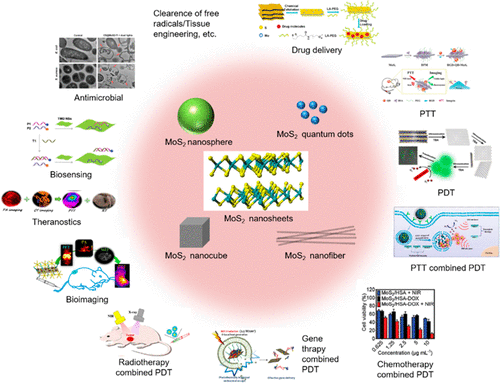当前位置:
X-MOL 学术
›
ACS Mater. Lett.
›
论文详情
Our official English website, www.x-mol.net, welcomes your
feedback! (Note: you will need to create a separate account there.)
Functionalized MoS2-Based Nanomaterials for Cancer Phototherapy and Other Biomedical Applications
ACS Materials Letters ( IF 9.6 ) Pub Date : 2021-03-29 , DOI: 10.1021/acsmaterialslett.1c00073 Meng Liu 1 , Houjuan Zhu 2, 3, 4 , Yan Wang 5 , Cansu Sevencan 1 , Bang Lin Li 6
ACS Materials Letters ( IF 9.6 ) Pub Date : 2021-03-29 , DOI: 10.1021/acsmaterialslett.1c00073 Meng Liu 1 , Houjuan Zhu 2, 3, 4 , Yan Wang 5 , Cansu Sevencan 1 , Bang Lin Li 6
Affiliation

|
Transition-metal dichalcogenides (TMDs), as a novel category of nanomaterials and a potential alternate to graphene, are attracting great interest of researchers, because of their strong conductivity, superior catalytic performance, and good optical properties. As the most representative type of all TMDs, molybdenum disulfide (MoS2)-based nanomaterials are expanded into two-dimensional (2D) nanosheets, quantum dots (QDs), flower-like nanoparticles, nanospheres and nanotubes. These types are regarded as promising nanoplatforms for various applications in biomedicine, such as drug delivery, phototherapy, biosensing, bioimaging, theranostics, and antimicrobials, because of the unique planar structures, superb electronic and optical properties (such as thickness-dependent bandgap, strong near-infrared absorbance, and large surface area), and easily functionalized surface sites. Until now, there have been a few reviews about MoS2-based nanomaterials, with regard to functionalization for improvement of properties, such as high drug loading efficiency, dispersibility, physiological stability, biocompatibility, targeting ability, pharmacodynamics, controllable drug release, enhanced treatment and therapeautic efficacy, and even biodegradability and toxicity reduction. Here, we systematically summarized the progress of functionalized MoS2-based nanomaterials with improved physicochemical and biological properties for the biomedical applications. First, we emphatically introduced these biomedical applications in drug delivery, anticancer photothermal therapy (PTT), photodynamic therapy (PDT), and combined phototherapy. Besides, other biomedical applications were also introduced in detail including bioimaging, biosensing, theranostics, toxicity, tissue engineering, and antimicrobials. Lastly, the current challenges, opportunities and prospects of MoS2-based nanomaterials were also discussed in depth. We expect that this review will contribute to a quick and in-depth understanding of the latest progress in bioapplication of MoS2-based nanomaterials, inspiring the creation of various techniques to design and fabricate MoS2-based nanomaterials with multiple capability and high biological safety, and expand them into more application in the field of biomedicine.
中文翻译:

基于功能化的基于MoS 2的纳米材料,用于癌症光疗和其他生物医学应用
过渡金属二硫化碳(TMDs)作为一种新型的纳米材料,是石墨烯的潜在替代品,因为它们的强电导率,优异的催化性能和良好的光学性能,引起了研究人员的极大兴趣。作为所有TMD中最具代表性的类型,二硫化钼(MoS 2基于纳米的材料被扩展为二维(2D)纳米片,量子点(QD),花状纳米颗粒,纳米球和纳米管。由于独特的平面结构,出色的电子和光学特性(例如与厚度有关的带隙,坚固,坚固,坚固耐用),这些类型被认为是在生物医学中的各种应用(如药物输送,光疗,生物传感,生物成像,治疗学和抗菌剂)中有希望的纳米平台。近红外吸收率和较大的表面积),以及易于功能化的表面部位。到目前为止,关于MoS 2已有一些评论-基纳米材料,涉及功能改善以改善性能,例如高载药效率,分散性,生理稳定性,生物相容性,靶向能力,药效学,可控药物释放,增强的治疗和治疗功效,甚至生物降解性和毒性降低。在这里,我们系统地总结了功能化MoS 2的进展基纳米材料具有改善的理化和生物学特性,可用于生物医学应用。首先,我们着重介绍了这些生物医学在药物递送,抗癌光热疗法(PTT),光动力疗法(PDT)和联合光疗中的应用。此外,还详细介绍了其他生物医学应用,包括生物成像,生物传感,治疗学,毒性,组织工程学和抗菌剂。最后,还深入讨论了MoS 2基纳米材料的当前挑战,机遇和前景。我们希望这次审查将有助于快速深入地了解基于MoS 2的纳米材料在生物应用中的最新进展,从而激发各种设计和制造MoS的技术的创造。具有多种功能和较高的生物安全性的2基纳米材料,并将其扩展到生物医学领域中的更多应用。
更新日期:2021-05-03
中文翻译:

基于功能化的基于MoS 2的纳米材料,用于癌症光疗和其他生物医学应用
过渡金属二硫化碳(TMDs)作为一种新型的纳米材料,是石墨烯的潜在替代品,因为它们的强电导率,优异的催化性能和良好的光学性能,引起了研究人员的极大兴趣。作为所有TMD中最具代表性的类型,二硫化钼(MoS 2基于纳米的材料被扩展为二维(2D)纳米片,量子点(QD),花状纳米颗粒,纳米球和纳米管。由于独特的平面结构,出色的电子和光学特性(例如与厚度有关的带隙,坚固,坚固,坚固耐用),这些类型被认为是在生物医学中的各种应用(如药物输送,光疗,生物传感,生物成像,治疗学和抗菌剂)中有希望的纳米平台。近红外吸收率和较大的表面积),以及易于功能化的表面部位。到目前为止,关于MoS 2已有一些评论-基纳米材料,涉及功能改善以改善性能,例如高载药效率,分散性,生理稳定性,生物相容性,靶向能力,药效学,可控药物释放,增强的治疗和治疗功效,甚至生物降解性和毒性降低。在这里,我们系统地总结了功能化MoS 2的进展基纳米材料具有改善的理化和生物学特性,可用于生物医学应用。首先,我们着重介绍了这些生物医学在药物递送,抗癌光热疗法(PTT),光动力疗法(PDT)和联合光疗中的应用。此外,还详细介绍了其他生物医学应用,包括生物成像,生物传感,治疗学,毒性,组织工程学和抗菌剂。最后,还深入讨论了MoS 2基纳米材料的当前挑战,机遇和前景。我们希望这次审查将有助于快速深入地了解基于MoS 2的纳米材料在生物应用中的最新进展,从而激发各种设计和制造MoS的技术的创造。具有多种功能和较高的生物安全性的2基纳米材料,并将其扩展到生物医学领域中的更多应用。
















































 京公网安备 11010802027423号
京公网安备 11010802027423号